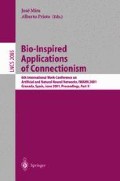Abstract
To study the relevance of recurrent neural network structures for the behavior of autonomous agents a series of experiments with miniature robots is performed. A special evolutionary algorithm is used to generate netw orks of different sizes and architectures. Solutions for obstacle a voidance and phototropic behavior are presented. Networks are evolved with the help of simulated robots, and the results are validated with the use of physical robots.
Access this chapter
Tax calculation will be finalised at checkout
Purchases are for personal use only
Preview
Unable to display preview. Download preview PDF.
References
Husbands, P., and Harwey, I. (1992) Evolution versus design: Controlling autonomous robots, in: Integrating perception, planning and action: Proceedings of the Third Annual Conferences on Artificial Intelligence, IEEE Press, Los Alamitos.
Michel, O., Khepera Simulator Package version 2.0: Freeware mobile robot simulator written at the University of Nice Sophia-Antipolis by Oliver Michel. Downloadable from the World Wide Web at http://wwwi3s.unice.fr/~om/khep-sim.html
Mondala, F., Franzi, E., and Ienne, P. (1993), Mobile robots miniturization: a tool for investigation in control algorithms, in: Proceedings of ISER'’93, Kyoto, October 1993.
Nolfi, S., and Floreano, D. (2000) Evolutionary Robotics: The Biology, Intelligence, and Technology of Self-Organizing Machines MIT Press, Cambridge.
Pasemann, F. (1993), Dynamics of a single model neuron, International Journal of Bifurcation and Chaos, 2, 271–278.
Pasemann, F. (1998), Evolving neurocontrollers for balancing an inverted pendulum, Network: Computation in Neural Systems, 9, 495–511.
Pfeifer, R., and Scheier, C. (2000), Understanding Intelligence, MIT Press, Cambridge.
Author information
Authors and Affiliations
Editor information
Editors and Affiliations
Rights and permissions
Copyright information
© 2001 Springer-Verlag Berlin Heidelberg
About this paper
Cite this paper
Pasemann, F., Steinmetz, U., Hülse, M., Lara2, B. (2001). Evolving Brain Structures for Robot Control. In: Mira, J., Prieto, A. (eds) Bio-Inspired Applications of Connectionism. IWANN 2001. Lecture Notes in Computer Science, vol 2085. Springer, Berlin, Heidelberg. https://doi.org/10.1007/3-540-45723-2_49
Download citation
DOI: https://doi.org/10.1007/3-540-45723-2_49
Published:
Publisher Name: Springer, Berlin, Heidelberg
Print ISBN: 978-3-540-42237-2
Online ISBN: 978-3-540-45723-7
eBook Packages: Springer Book Archive

